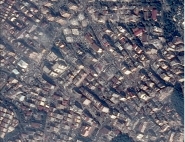Risk Map
What is a risk map for a community?
A risk map is a map of a community or a geographic area, indicating the places and buildings - houses, schools, hospitals, etc. - which could suffer damage in the event of hurricanes, earthquakes, tidal waves, flooding, volcanic eruptions, landslides and other natural risks or as a result of the technical or environmental consequences of such risks.
Drawing up a risk map requires a collective effort. A large number of specialists in various fields - management of emergency situations, geology, meteorology, history or simply good knowledge of the region or place - contribute to this effort by indicating the points where there are areas of risk.
Hazard map
Flooding hazard map | Once it has been identified, the hazard is mapped. For the flooding hazard, therefore, and depending on the studies, archives and topographical readings, we draw the 30-year flooding map (occurring every 30 years, on average). |
Map of issues at stake
Map of issues at stake | Two types of information are shown on this map:
|
Risk map
Flooding risk map | This is obtained by superposing the hazard map on the map of issues at stake; we can see, for example, that for the flooding risk, plans must be made to evacuate the hospital and to move the transformer, etc. Different colours can be used to indicate whether the risk involved is major, moderate or minor. |
